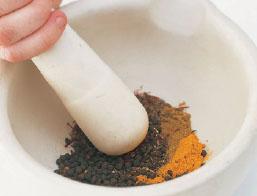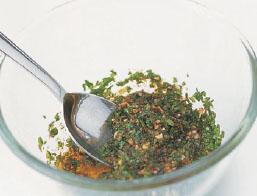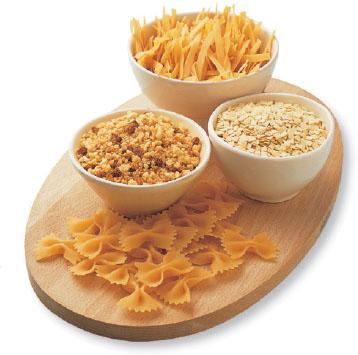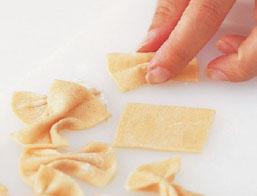Kosher and Traditional Jewish Cooking: Authentic Recipes From a Classic Culinary Heritage: 130 Delicious Dishes Shown in 220 Stunning Photographs (44 page)
Authors: Marlena Spieler

2
When the chillies are cool enough to handle, carefully remove the stems, seeds and membrane, then pound to a purée with 10 garlic cloves, and 5ml/1 tsp each of ground coriander, caraway and cumin in a mortar with a pestle.
3
Add 2.5ml/
1
/
2
tsp salt and 15ml/1 tbsp extra virgin olive oil to the mixture. Stir in enough cold water to make a thick paste.
This fragrant mixture of spices comes from Yemen. It is delicious in stews, soups and sauces.

1
Place 30ml/2 tbsp black peppercorns and 15ml/1 tbsp caraway seeds in a spice grinder, or use a pestle and mortar.
2
Add 10ml/2 tsp each of ground cumin and turmeric, 5ml/1 tsp cardamom seeds and several pinches of saffron threads. Process to a powder and keep in a tightly sealed jar in a cool, dark place.
This Ethiopian spice mixture is based on hot chillies.
1
Mix 90g/3
1
/
2
oz paprika with 10ml/2 tsp cayenne pepper, the seeds from 20 cardamom pods, 2.5ml/
1
/
2
tsp ground fenugreek seeds, 1.5ml/
1
/
4
tsp each of ground ginger and freshly grated nutmeg, and generous pinches of black pepper, cloves, ground cinnamon and allspice.
2
Lightly toast the mixture in a hot, ungreased pan for less than a minute. When cool, store in a sealed jar.
This moist mixture of herbs, spices and aromatics comes from North Africa. It is mainly used as a marinade for fish but is also good with chicken, potatoes and other vegetables.
1
In a bowl, combine 75ml/5 tbsp extra virgin olive oil with 30ml/2 tbsp lemon juice, 4–5 crushed garlic cloves and 10ml/2 tsp ground cumin.
2
Stir 15ml/1 tbsp paprika, 1.5ml/
1
/
4
tsp ground ginger and 1 chopped fresh chilli or a pinch of chilli powder into the spice mixture.

3
Add 90ml/6 tbsp chopped fresh coriander (cilantro) leaves and a little flat leaf parsley or mint, if you like, to the bowl, season with salt and mix well or purée to a smooth paste.
There are a number of other flavouring ingredients that play an essential role in Jewish cooking.
Salt is not just used as a seasoning but also plays a role in ritual, especially in kashering. It is seen as a purifying agent and, in biblical times, it was sacrificed at the Temple in Jerusalem. In Morocco, Jews sprinkle salt on newborn babies, to ward off the evil eye. At the Pesach Seder, it is dissolved in water and used to represent the tears of Israelite slaves.
Sour salt (citric acid)
is a great favourite in the Ashkenazi kitchen and is used instead of lemon to add a sour taste to dishes such as borscht.
Honey
has been much loved by Jews since the biblical description of Israel as a land flowing with milk and honey. It is used to represent the sweetness of the year to come at Rosh Hashanah.
Rose water and orange flower water
are fragrant essences used in sweet and savoury dishes. They are added to the syrups poured over sweet pastries, and couscous dishes.
Halek
, also known as dibis, is a thick date syrup used to flavour foods. It is available in jars, but you can make your own. Reconstitute dried dates in water, then boil in a little water until soft. Purée, then strain into a pan and cook over a medium heat until thick.
These are the herbs that feature at Pesach. Karpas is the mild herb eaten at the Seder meal. It might be leaves of young lettuce, as favoured in the Sephardi tradition, or parsley, as favoured by the Ashkenazim. Moror are the bitter herbs, eaten as a reminder of the tears shed by Hebrew slaves in Egypt. Grated horseradish is often used, or the bitter greens might be represented by chicory (Belgian endive) or watercress.
and
savoury pastries
Noodles were once the pride of the Ashkenazi kitchen, and were cut into a variety of shapes, then served in soup, tossed with sour cream or cheese, or layered with other ingredients and baked into puddings known as kugels. Since biblical times pancakes have been very popular. They are usually either very thin and filled or thick and crispy. Generations of Jewish cooks have delighted in dumplings, especially knaidlach made from matzo meal and egg. Savoury pastries are popular with both Ashkenazi and Sephardi Jews.
These were probably introduced to German Ashkenazi kitchens during the 14th century, via the Italian Jews. This was long before they reached the non-Jewish German kitchen during the 16th century. Pasta came to Poland at the same time, possibly through Central Asia, and the Yiddish word for noodles (
lokshen
) comes from the Polish word
lokszyn
. The sauces of the Polish Yiddish kitchen also showed a Central Asian slant. They were based on yogurt, sour cream and fresh cheeses, rather than the rich tomato sauces of Italian extraction. Sephardi cooking showed a more distinctive Italian or Spanish influence, as evidenced in kelsonnes, dumplings filled with cheese and eaten at the festival of Shavuot, and calzonicchi, which are filled with spinach and enjoyed for Purim.
Egg noodles are still made at home for special occasions. This is easy to do with a pasta-rolling machine, but they can also be rolled by hand on a well-floured surface.
1
Sift 225g/8oz/2 cups plain (all-purpose) flour and 2.5ml/
1
/
2
tsp salt into a large bowl, making a well in the centre.

2
Pour two lightly beaten eggs into the flour and mix with a fork, gradually incorporating the eggs into the flour. Continue to stir, using a wooden spoon, until combined. Alternatively, place all the ingredients in a food processor fitted with the metal blade and mix to form a dough.

Lokshen, farfel, varnishkes and plaetschen are just a few of the classic noodles from the Ashkenazi kitchen.
3
Turn the dough on to a floured board and knead until smooth and elastic. Place in a plastic bag, seal and leave for at least 30 minutes.
4
If using a pasta-rolling machine, roll out walnut-size balls of the dough, then, one at a time, feed the dough into the largest opening of the rollers. Fold the flattened dough and repeat, reducing the roller opening until the dough is the desired thickness.
5
If rolling by hand, divide the dough into three equal pieces, then roll out each piece on a floured surface, until it is extremely thin.
Lightly sprinkle the sheets of rolled noodle dough with flour, then cut into the desired shape. To cook, drop the pasta into a large pan of boiling salted water and cook for 2–4 minutes.
To make lokshen (flat noodles), roll a sheet of noodle dough into a tight scroll. Using a sharp knife, cut the dough crossways into narrow or wide strips, as desired. Unroll the strips, boil
and serve with sauce, in soup or baked together with other ingredients in a kugel.
To make plaetschen (little squares), cut a sheet of noodle dough into 1cm/
1
/
2
in squares. Boil and then serve in soup.

To make varnishkes (butterflies), cut a sheet of noodle dough into 2.5cm/1in squares. Pinch each square in the centre to form a bow tie or butterfly. Boil and serve in soup or with kasha.
